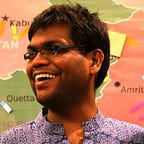The Eye of the Beholder
(This book review was first published in Business Standard.)
Why would you want to read a book about love? Do you care to learn from people who can theorize about this subject? Are you trying to be a better lover? Do you think that life has passed you by, and you haven’t found your beloved yet? Are you simply curious about the intense, abiding human need to love and be loved? Here’s my reason: In a pandemic-stricken world that heightens the awareness of impermanence and uncertainty, love might be one of the few remaining frameworks to make meaning and find purpose.
Love is not a Word: The Culture and Politics of Desire (2020) is a collection of 12 essays edited by Debotri Dhar, and published by Speaking Tiger. The editor teaches Women’s Studies at the University of Michigan in the United States. Her anthology brings together writing by Alka Pande, Christina Dhanaraj, Didier Coste, Makarand R. Paranjape, Malashri Lal, Mehr Afshan Farooqi, Nilanjan Mukhopadhyay, Parvati Sharma, Rakhshanda Jalil, Sumana Roy, Zafar Anjum, and herself.
People have been writing about love for centuries, so it is perhaps difficult for writers to come up with something new to say and for an editor to curate in radically inventive ways. There is a tendency to fall back on familiar tropes, ideas and texts. That happens with this volume as well. There are essays about arranged marriage, Radha-Krishna, Urdu love poetry, songs of separation, single women and self-love, the Kama Sutra, same-sex love, and the so-called love jihad. If you are looking for variety, you will find it here. If you seek fresh perspectives, this book might be a bit disappointing.
The one essay that really stands out for me in this whole book is ‘Swipe Me Left, I’m Dalit’, written by Dhanaraj. She says, “After many relationships, I’ve now come to realise that not only can caste play a role in determining the success of one’s romantic pursuit, it can also shape one’s competence, desirability, and confidence within a relationship. And love, contrary to what we have been taught, may not be the most sacred of all feelings, insulated from the world and pure in its expression; it is a choice that we make based on who we are and where we come from.”
Dhar reveals that this essay is part of the collection because it “uses a Dalit feminist lens to shed light on the romantic experiences of Dalit women who have to bear the double burden of caste and gender.” Dhanaraj does a commendable job of challenging the assumption that love is simply a private matter between two individuals who care about each other. A former partner of hers ended their relationship because his parents could not accept the fact that she was Dalit. Another person told her that his family might approve if she did not “behave like a Dalit.” If love is not willing to cut through this deep-seated prejudice, is it really the redemptive force it is supposed to be?
Dhanaraj’s essay makes an impact because she questions the hype around how online dating is breaking social barriers in India since most Indians “still legitimize their unions based on caste markers, such as surnames, localities, dialects, parents’ jobs, religion, economic status, political and pop culture idols, food choices, ideology, and skin colour.” She also argues that the liberal feminist discourse around sexual agency, polyamory, casual sex, open relationships is predominantly led by “women from upper-caste/ bourgeoise locations” and “it could potentially be exploitative for Dalit women.”
The other memorable essay in this book is Sumana Roy’s ‘How to Write a Love Letter to a Tree’. Being a lover, she says, is one of her primary identities. “In an alternate world, I’d have put this as the first entry on my CV. Unfortunately, that doesn’t seem to count for much, not in the professional world where love is pretty useless, and increasingly not in relationships either, where things besides love decide the fate of romantic relationships. And as I found, it also doesn’t count if the object of one’s affection is a non-human,” she says.
Roy writes with humour and emotion about how she found herself rejecting “the botanist or environmentalist’s investigative curiosity about plants.” Her intention was clear and focused. She wanted to learn how to show love to plants. She writes, “It is amazing that there really is no way — no methodology, no ritual — of demonstrating one’s love to a favourite, a beloved, tree…I realised that I was in love not with one tree but with several, perhaps in love with all the trees there were. Do you realise what that made me in terms of a human equivalent?”
